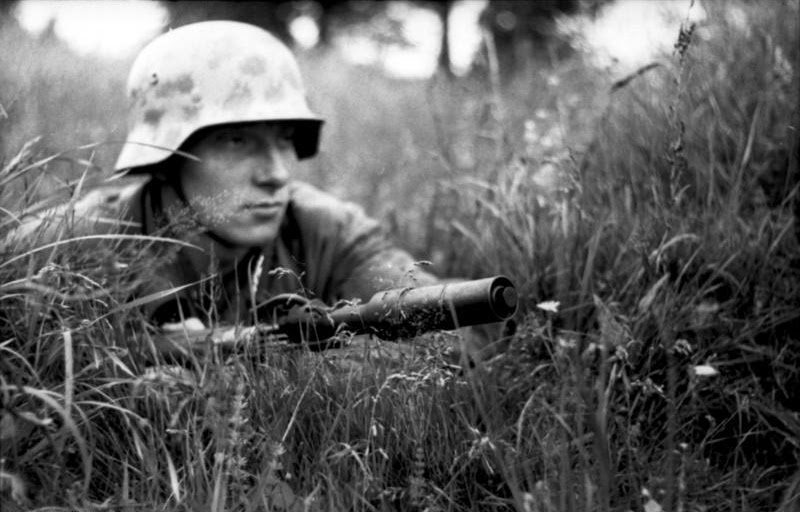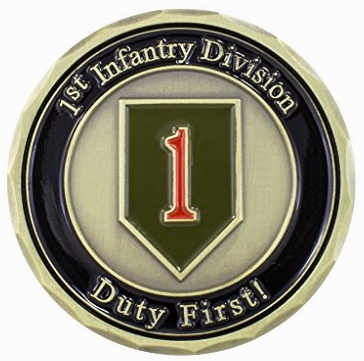
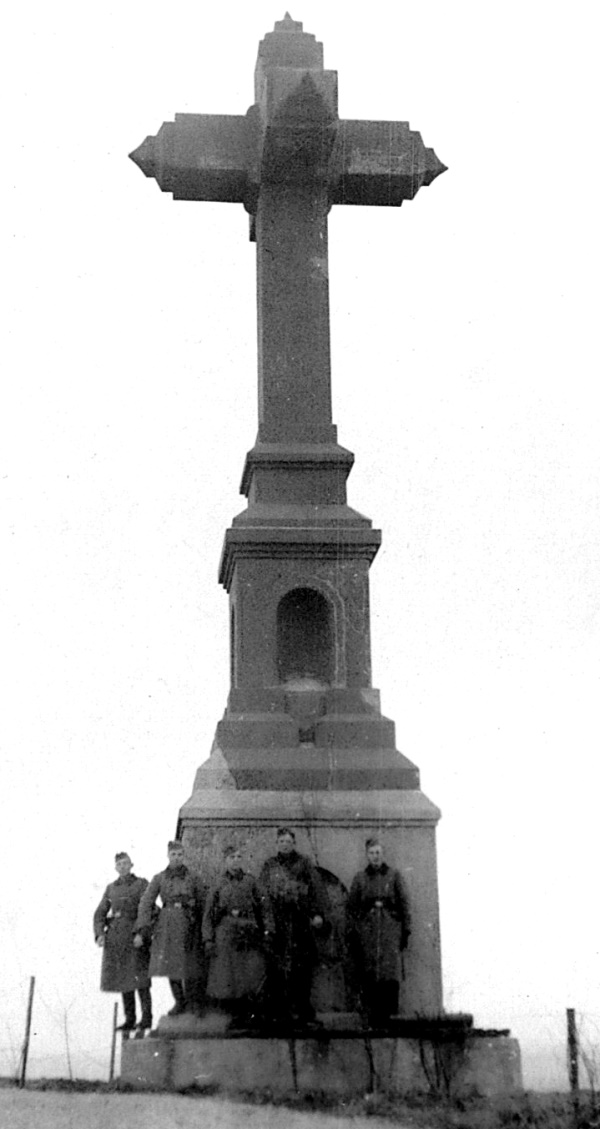 Operation Report of Charlie Company, 18th Infantry Regiment, 1st Infantry Division (Big Red One), Attack on the Crucifix Hill (Hill 239 – Haarberg), Aachen (Aix-la-Chapelle), Germany, Rhineland Campaign – October 8-9 1944. Personal experience of a Company Commander.
Operation Report of Charlie Company, 18th Infantry Regiment, 1st Infantry Division (Big Red One), Attack on the Crucifix Hill (Hill 239 – Haarberg), Aachen (Aix-la-Chapelle), Germany, Rhineland Campaign – October 8-9 1944. Personal experience of a Company Commander.
Capt Bobbie E. Brown
This archive covers the operations of Charlie Company, 1st Battalion (Col Henry G. Leonard), 18th Infantry Regiment (Col George A. Smith), 1st Infantry Division (Big Red One) opposed to the German 246.Volks-Grenadier-Division, during the capture of Crucifix Hill, Haarberg, Hill 239, Haaren, in the vicinity of Aachen, Germany, during the period of Oct 8 to Oct 9, 1944 (Rhineland Campaign). This is the personal experience of the company commander of Charlie Company.
Introduction
In the initial landings in Normandy, the 1st Infantry Division was one of the assaulting divisions. It landed on D-Day and rapidly pushed to Caumont. When the American forces broke out of the beachhead in July at St Lô, the 1-ID was one of the divisions rushed through the gap to exploit the breakthrough. Following the breakthrough, the Division swung wide and was able to help close the trap on the Germane in the Falaise Pocket. After the Falaise Pocket action, the 1-ID raced across France, by-passing Paris, toward Soisson, the famous battleground of the Big Red One Division during WW-1. From Soisson, the 1-ID swung north towards Mons in Belgium. Here, in September, the Division dealt the Germans a severe defeat, having captured over 17.000 prisoners and killing nearly 5000 Germans as they attempted to evacuate France then Belgium to occupy the Siegfried Line near Aachen, Germany. Following this action, the 1-ID turned towards Aachen, where it was assigned the mission of penetrating the Siegfried Line.
Aachen – Terrain Features
The country surrounding Aachen may best be described as rolling hills interspersed with woods and higher ridges. Small towns and villages were numerous in the area. These towns were generally in the lowlands and some were only a few thousand yards apart. The villages were all of masons and stone construction. These had been bombed considerably before we got there, and most of them were nothing but heaps of rubble. In some villages, the rubble was so high that tanks could not get through it. Southwest of Aachen was the Aachen State Forest. This was very thickly wooded, the trees averaging 25-35 feet in height. The slopes were very steep throughout the forest.
Crucifix Hill & Siegfried Line
 The Siegfried Line, extending along the 18th Infantry Regiment’s zone of action, consisted of a solid, intricately-fashioned front of strong
The Siegfried Line, extending along the 18th Infantry Regiment’s zone of action, consisted of a solid, intricately-fashioned front of strong 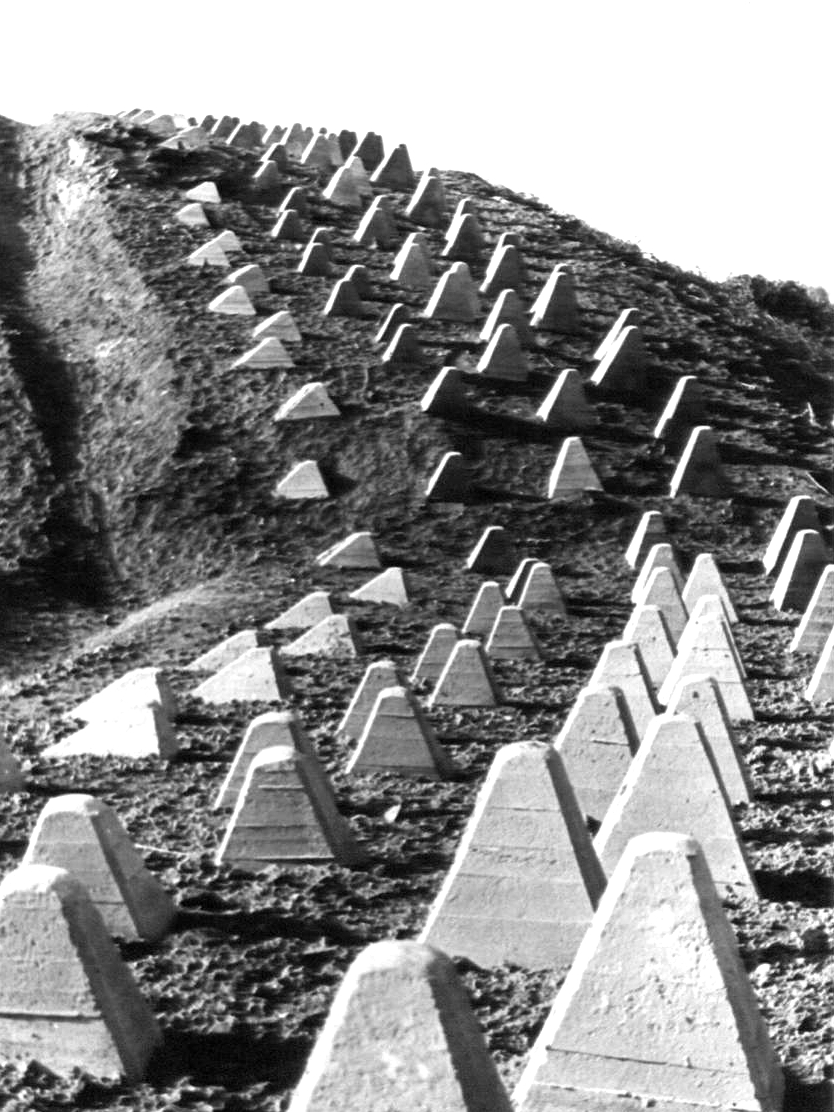 points defending the West Wall of Germany. Such a strong point was Crucifix Hill, so named because a large crucifix stood at the top of it. These strong points were comprised of specially dug AT ditches, mined areas, natural and artificial obstacles; fortified houses and sheds and garages; well-concealed concrete installations of pillboxes and emplacement; dug-in tanks and tank turrets used as stationary pillboxes; trenches, foxholes; slit-trenches and large open emplacements for machine-gun nests, 88-MM Artillery guns, AT and AAA guns, automatic weapons and heavier artillery.
points defending the West Wall of Germany. Such a strong point was Crucifix Hill, so named because a large crucifix stood at the top of it. These strong points were comprised of specially dug AT ditches, mined areas, natural and artificial obstacles; fortified houses and sheds and garages; well-concealed concrete installations of pillboxes and emplacement; dug-in tanks and tank turrets used as stationary pillboxes; trenches, foxholes; slit-trenches and large open emplacements for machine-gun nests, 88-MM Artillery guns, AT and AAA guns, automatic weapons and heavier artillery.
 The ditches and mine areas were the first barriers. The ditches, 12′ (3.6 M) wide, 41′ (12.5 M) deep, were 75 yards (70 M) in front of the dragon’s teeth. The dragon’s teeth formed a belt 50′ (15 M) wide, with a concrete wall on both sides. On our side they were 2’7 high (0.8 M); toward the enemy, they were 4’10 high (1.2 M). Behind the dragon’s teeth and on commanding ground covering all approaches to the AT ditches and concrete barriers, were a series of concrete installations of pillboxes and emplacements.
The ditches and mine areas were the first barriers. The ditches, 12′ (3.6 M) wide, 41′ (12.5 M) deep, were 75 yards (70 M) in front of the dragon’s teeth. The dragon’s teeth formed a belt 50′ (15 M) wide, with a concrete wall on both sides. On our side they were 2’7 high (0.8 M); toward the enemy, they were 4’10 high (1.2 M). Behind the dragon’s teeth and on commanding ground covering all approaches to the AT ditches and concrete barriers, were a series of concrete installations of pillboxes and emplacements.
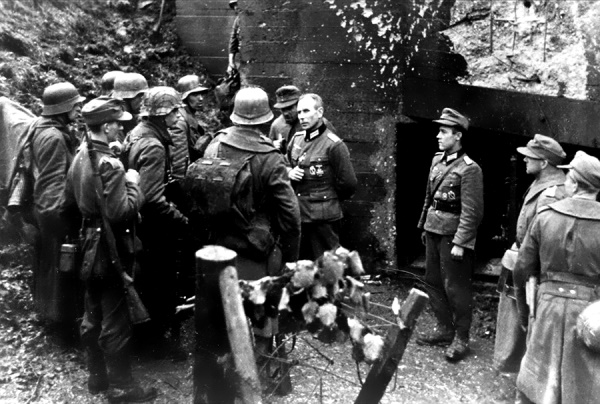 The pillboxes averaged 87′ (26.5 M) in circumference, 6′ (1.8 M) in depth from top to bottom inside, and were expertly and completely covered, excluding the turrets, with brush and long grass.
The pillboxes averaged 87′ (26.5 M) in circumference, 6′ (1.8 M) in depth from top to bottom inside, and were expertly and completely covered, excluding the turrets, with brush and long grass.
The bunkers were normally 20-30 feet (6-9 M) by 40-50 feet (12-15 M), and 20-25 feet in height (6-7.5 M), of which at least half was below the ground.
The underground parts were made to contain a great quantity of ammunition; bunks for the defenders; steel doors; and ventilator systems.
 Surrounding these bunkers were trenches with machine-gun nests, AT guns, and open earthworks for heavier artillery. Also present were tank turret pillboxes, which were flanked by machine-gun positions.
Surrounding these bunkers were trenches with machine-gun nests, AT guns, and open earthworks for heavier artillery. Also present were tank turret pillboxes, which were flanked by machine-gun positions.
These tank turret pillboxes were usually situated near crossroads with rotary fields of fire in all directions ranging from 250 to 500 yards (225 to 450 M) of open, commanding observation. These turrets were 19′ (5.7 M) in circumference, 2’6 (0.8 M) above the ground, and were 3′ (0.9 M) thick (steel) with 6 apertures and 6 peepholes. Such was the organization of a strong point. Most of them, including Crucifix Hill, were supported by artillery and high-Velocity direct-fire weapons.
Preliminary Preparations
Six days prior to the attack the battalion was placed in a reorganizing area, 8000 yards southwest of Aachen. Here the battalion was reorganized into small assault groups for the next attack on the Siegfried Line. We received replacements, which brought the battalion up to the regular strength. The battalion commander and his staff drew up an assault training program, and the next six days were spent at hard training. The battalion was trained on dummy pillboxes. The dummy pillboxes were abandoned enemy tanks and built-up mounds of earth. We were also trained to reorganize from small assault groups to the normal defensive positions.
 For the next mission, Charlie Co was assigned the task of capturing Crucifix Hill. For this assault, Charlie was deployed as follows: 1 one Ranger Plat. was assigned the mission of flank security; 2. the 2nd Plat. was the base platoon and was to assault on the left of the trail leading west from Verlautenheide, the trail inclusive to the 2nd Plat.; 3. the 1st Plat. was to assault along the right, and to use the trail; 4. the 3rd or Support Plat. was to support by fire from the position, in an old cemetery west of Verlautenheide, and be prepared to come forward on call. We had maps of the area we were to assault with the know pillboxes marked on them. Each small unit knew what bunker or pillbox it was to assault and just where they fitted into the company picture. This type of training was very beneficial, and it paid off in the end; it should be stressed from the highest to the smallest unit commander.
For the next mission, Charlie Co was assigned the task of capturing Crucifix Hill. For this assault, Charlie was deployed as follows: 1 one Ranger Plat. was assigned the mission of flank security; 2. the 2nd Plat. was the base platoon and was to assault on the left of the trail leading west from Verlautenheide, the trail inclusive to the 2nd Plat.; 3. the 1st Plat. was to assault along the right, and to use the trail; 4. the 3rd or Support Plat. was to support by fire from the position, in an old cemetery west of Verlautenheide, and be prepared to come forward on call. We had maps of the area we were to assault with the know pillboxes marked on them. Each small unit knew what bunker or pillbox it was to assault and just where they fitted into the company picture. This type of training was very beneficial, and it paid off in the end; it should be stressed from the highest to the smallest unit commander.
Orders were received on Oct 7, calling for a series of continuing attacks by the 2/18-IR, the 1/18-IR, and the 3/18-IR, in that order. First, the 2/18, using Eilendorf as a base, was to seize Verlautenheide. Immediately upon its seizure and organization, the 1/18 was to jump off from the town for its assault on Crucifix Hill. Following the capture of the Hill, the 3/18 was to be in regimental reserve during the capture of Verlautenheide and Crucifix Hill. Their complete leapfrog maneuver would deny the Aachen garrison a route of supply, and when contact could be made with units of the 30-ID pressing down south of Würselen, it would be isolated from the rest of Germany.
 It was planned that the 2/18 would seize Verlautenheide and block the northeast; they would assist by fire the attack by the 1/18 on the objective. The 1/18 would seize Crucifix Hill, 900 yards west of Verlauntenheide, and cut, by fire and mines, the Haaren – Zuiweden road northwest of Crucifix Hill. The 3/18 was to seize the low ridge and Hill 192 northwest of Eilendorf and then prepared to seize Haaren on order. The 1/18 plan called for the unit to assemble in Verlautneheide with the least possible delay, and prepare to attack on order. Charlie Co along the ridgelines west of Verlautneheide was to seize Crucifix Hill. Able Co would attack on the left of Charlie Co, seize pillboxes 4 pillboxes (#17 #18 #19 #20), and open emplacements to tie in with Charlie Co at the trail south of pillbox another pillbox (#33). Baker Co was to remain in Battalion reserve in Verlauntenheide. They were to be prepared to assist either assault.
It was planned that the 2/18 would seize Verlautenheide and block the northeast; they would assist by fire the attack by the 1/18 on the objective. The 1/18 would seize Crucifix Hill, 900 yards west of Verlauntenheide, and cut, by fire and mines, the Haaren – Zuiweden road northwest of Crucifix Hill. The 3/18 was to seize the low ridge and Hill 192 northwest of Eilendorf and then prepared to seize Haaren on order. The 1/18 plan called for the unit to assemble in Verlautneheide with the least possible delay, and prepare to attack on order. Charlie Co along the ridgelines west of Verlautneheide was to seize Crucifix Hill. Able Co would attack on the left of Charlie Co, seize pillboxes 4 pillboxes (#17 #18 #19 #20), and open emplacements to tie in with Charlie Co at the trail south of pillbox another pillbox (#33). Baker Co was to remain in Battalion reserve in Verlauntenheide. They were to be prepared to assist either assault.
The supporting fires were as Follows, 1 Battalion (Light Artillery), the 32nd Field Artillery Battalion; 4 Guns, 155-MM in Eilendorf; 1 Platoon M-10 TDs from the 634-TDB, Eilendorf; 1 Platoon Tanks from the 745-TB, Eilendorf, and the Battalion’s 81-MM Mortars. The TDs were in position in Eilendorf in direct fire positions. The Artillery was placed, initially, in direct fire positions. The 81-MM mortars went forward. All the direct supporting fires could fire on the south side of Crucifix Hill, and keep up the fire until the assault groups signaled to lift the fires for the final assault. Detailed observations were made daily on Crucifix Hill and vicinity by all the officers of the Battalion, from Oct 2 to Oct 7. Most of the Platoon’s sergeants and squad leaders went on the same recon daily. All plans were completed in the present area, and at the time we didn’t know on what day the attack would take place. At the Battalion CP, we had access to late aerial photos of Crucifix Hill and it’s vicinity.
On Oct 7, Capt Edward W. McGreoger, Battalion S-3, and I went on a day-long study of the objective area from the forward CP’s of King 18-IR as well as CPs from Easy and Fox 16-IR north in Eilendorf. We returned to Battalion CP at about 1800 on Oct 7. The Battalion had been alerted to the fact that the attack would take place on Oct 8 with H hour at 0400. The Battalion Maintenance Co had picked up trucks from the Engineer Combat Group, which had relieved the 1/18 in the Aachen State Forest on Oct 2. These trucks were convoyed to the battalion bivouac area. The Battalion in trucked at dark with attached units, left the assembly area at 2000, and traveled east by truck and attached tanks to a detrucking point in Brand. This point was reached at 2300. The 26-IR was ordered to turn over all motor on trucks and tanks, to deceive the enemy of the 18-IR move to Brand and Eilendorf. The Battalion detrucked in Brand and remained there until 0045. They then moved in a column of companies to Eilendorf, and took cover in cellars to wait for the 2/18 to capture Verlautenheide.
At 0400 on Oct 8, a friendly artillery barrage, consisting of eleven artillery battalions pounded Verlautenheide and Crucifix Hill for one hour prior to the attack of the 2/18 on its objective. After the 2/18 had taken Verlautenheide the 1/18 would pass through the town to seize and secure Crucifix Hill. The 2/18 captured its objective by 0700. The 1/18 was ordered to start its approach march to its forward assembly area in Verlautenheide, about 0800. The Battalion Commander ordered the battalion to move out at once. The CO and forward command group arrived at the forward assembly area in Verlautenheide at 1000. As soon as Charlie Co arrived I reported to the battalion commander and explained to him the situation of the company and its condition. The company had been shelled all the way from Eilendorf, and I reported the companies casualties. The battalion commander wanted to know if we could attack at once. Capt McGreoger stepped up and said it would take Brown some time to get his company forward to his assembly area, which was to the cellars in Verlautenhide.
My Executive Officer, Lt Van Wagner had pushed up to where I was in Verlautenheide where I was looking for cellars for the company. At this time the enemy was shelling the town heavily. Lt Van Wagner had with him the company command group and part of two platoons. We placed  them in cellars, and Lt Van Wagner and I returned by way of the approach march route about 600 yards and got the rest of the company rolling again. The company was quickly reorganized and put into the cellars so as to keep each assault platoon together.
them in cellars, and Lt Van Wagner and I returned by way of the approach march route about 600 yards and got the rest of the company rolling again. The company was quickly reorganized and put into the cellars so as to keep each assault platoon together.
I had my artillery and the 81-MM mortar observers get on housetop, where they could observe the objective area. I also placed the Cal .50 machine-gun on housetops so they could have a good field of fire. I put out a covering force and had all platoon leaders join platoons to await my return from my ground recon. I had an SCR-536 radio sent to the Field Artillery Observer so as to keep contact with him, and with the 536 radio, walking west toward Crucifix Hill. I was out about 400 yards from Verlautenheide when I received machine-gun and rifle fire from south and southeast; the enemy also started dropping mortars near me. I hit the ground and crawled in the direction of the small arms fire and again several bursts of machine-gun fire came in my direction. I withdrew to a small cemetery in Verlautenheide where I had my covering force opened fire and three enemies put up their hands and surrendered. I took the prisoners to the CP where I discovered that the Ranger Plat. had twenty-two in a cellar. The man who found them was, Sgt David Cooper, who was later commissioned.
I got all the platoon leaders together and gave our plan of attack. The 1st Plat. would attack on the right trail leading to Crucifix Hill and be assigned their pillboxes by number. The bunkers or pillboxes had previously been numbered. The 2nd Plat. would assault on the left of the trail, and were assigned their pillboxes. The Ranger Plat. would act as left flank security and be assigned one pillbox. They were to engage the enemy on me while I made my recon. I would then be able to locate the pillboxes for them. They were also to block the rear of Crucifix Hill. The Browning Cal .50 and my Support Plat. were ordered to go into position to support the attack, and come forward on call. The 60-MM mortars would go in position west of Verlautenheide and move forward with the machine-guns and my Support Plat.
The 81-MM mortar observers and the artillery observers were to follow the last and 2d Plat. All platoons had a 536 radio, and I had extra SRC-300 radio that belonged to the Ranger Plat. This radio was left with my Executive Officer to enable me to have double contact with him.

 I checked to see that everyone knew the signals to lift fires or to call for fire. Finally, watches were set, and the time was 1140. All platoon leaders were directed to return to their platoons and give their men the instructions. At H hour I would give the signal to move out from my position with the 2nd Plat. The Ranger Platoon on the left would move out when they saw the 2nd Plat. move. The 1st Plat. would do likewise on the right. My Executive Officer and Communications Sergeant were present when the orders were issued. I returned to the CP. When I got there a message was in from the Regiment. When the message was cleared, it was found that we were to hold the attack on Crucifix Hill until 1330. I gave the Battalion CO all information about the enemy, and also informed him of my recon and plan of attack. He had no comments to make. I gave the attack time to my platoon leaders and told them I would lead out in front of the 2nd Plat. with my 300 radio operator and runner. I told them we would move out on the double since there was no cover from jump-off to the Hill. This movement would keep us from being in the open as short a time as possible. The terrain in front of the 1st and 2nd Plat. was open and flat while that before the Rangers was rolling. I made a check with the battalion commander to see if any change had been made in the plans.
I checked to see that everyone knew the signals to lift fires or to call for fire. Finally, watches were set, and the time was 1140. All platoon leaders were directed to return to their platoons and give their men the instructions. At H hour I would give the signal to move out from my position with the 2nd Plat. The Ranger Platoon on the left would move out when they saw the 2nd Plat. move. The 1st Plat. would do likewise on the right. My Executive Officer and Communications Sergeant were present when the orders were issued. I returned to the CP. When I got there a message was in from the Regiment. When the message was cleared, it was found that we were to hold the attack on Crucifix Hill until 1330. I gave the Battalion CO all information about the enemy, and also informed him of my recon and plan of attack. He had no comments to make. I gave the attack time to my platoon leaders and told them I would lead out in front of the 2nd Plat. with my 300 radio operator and runner. I told them we would move out on the double since there was no cover from jump-off to the Hill. This movement would keep us from being in the open as short a time as possible. The terrain in front of the 1st and 2nd Plat. was open and flat while that before the Rangers was rolling. I made a check with the battalion commander to see if any change had been made in the plans.
At the jump-off time, the Ranger Plat. came under fire from two strong points about 200 yards west of the cemetery. The firing was also coming in front of the advanced two assault platoons, but we kept pushing to the base of the Hill. As we hit the base of the objective area. My runner, radio operator, and I jumped over the embankment to an old trail well below the enemy fire. At this time my 536 radio operator got a message that Lt Cameron of the Ranger Plat. had been wounded, but he was still going and was assaulting the assigned pillbox. They were also engaged with two other enemy strong points.
I called the 1st and 2nd Plat. with my 536 radio and learned that both platoons were pinned down and could not move. I ordered Lt Marvain, (2nd Plat. Leader) to throw some pole and satchel charges over the bank. I was going to see if we could use them to knock out the bunkers covering the assault platoons. I was only ten yards from the platoon, but well below the fire holding them up. The first charge to come was a satchel charge. I picked the charge up and crawled to the pillbox and ran up to the aperture.
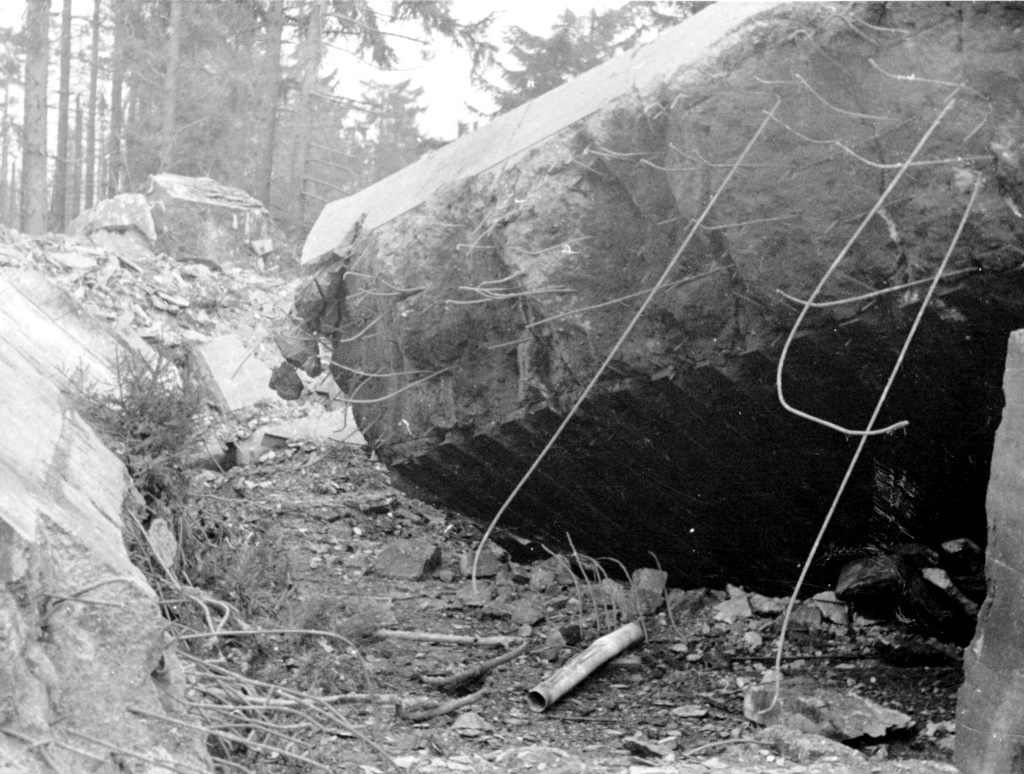 At the same time, an enemy rifleman opened the door and started out. However, when he saw me, he dashed back into fortification #23. I jumped at the door and tried to slam it shut; however, the excited enemy had left his rifle in the doorway. I opened the door at the same time I pulled the fuse on my charge and tossed it inside the bunker, slammed the door, and jumped back over the embankment as the pillbox and its occupants were blown up.
At the same time, an enemy rifleman opened the door and started out. However, when he saw me, he dashed back into fortification #23. I jumped at the door and tried to slam it shut; however, the excited enemy had left his rifle in the doorway. I opened the door at the same time I pulled the fuse on my charge and tossed it inside the bunker, slammed the door, and jumped back over the embankment as the pillbox and its occupants were blown up.
My radio operator got another message from the Rangers stating that Lt Cameron had been wounded a second time and that his platoon had destroyed pillbox number #22. My two assault platoons were still pinned down, and now we were receiving both artillery and mortar fire. My runners and I picked up more pole charges and satchel charges, moved near pillbox number #26, and fired a yellow smoke grenade signal on the south side of the pillbox for the 155-MM in Eilendorf to lift fire, so as to make the final assault on the bunker. This time it took both the pole charge and the satchel charge to do the job. This pulled the fire from the Ranger Plat. At the same time, I received a wound in my knee. When I returned to my runner he told me that he had a message from the Ranger Plat. Lt Cameron had been hit for the third time, and this time he had been killed. Sgt Wills, the platoon sergeant, was in command but could not move his platoon because of small arms and artillery fire. I could not contact the battalion commander to give him the situation; but part of the 2nd Plat. and one assault group had moved around with me on an old trail. The squad leader had been hit, and his second in command could not move out with the assault group. They had a flamethrower, so I assigned them to pillbox number #29, and with the  help of a good rifleman to keep the aperture closed another pillbox, the #24, was soon neutralized. This relieved the pressure on both assault platoons. I realized now that I had been wounded again once on the wrist and once on the chin. It probably happened when we were working on the last pillbox.
help of a good rifleman to keep the aperture closed another pillbox, the #24, was soon neutralized. This relieved the pressure on both assault platoons. I realized now that I had been wounded again once on the wrist and once on the chin. It probably happened when we were working on the last pillbox.
With pillboxes #23, #22, #26, #29, and #24 neutralized this took the grazing small arms fire from my assault platoons. As a result, both the 2d and 1st Plat. moved to their assigned pillboxes and were neutralizing them at a good speed. From my present position, I saw three pillboxes go out at one time from actions from the assault platoons. At the same time, I sent my runner back to my Executive Officer with an oral order to move up all the remaining detachments and support platoons to pillbox #26, to proceed to the Battalion CP and let the Battalion commander know the situation. It was now 1410 and my 300 radio made a contact with the battalion. We were nearing the Crucifix, but it had been shot down.
Lt Snyder, of the 1st Plat. had been wounded but was still fighting. I moved over with Lt Marvain, who was 2nd Plat. Leader and we rushed down the hill to a small cemetery near pillbox #39, which was to be his left sector. Pillbox #39 was not manned, but nine enemies lay dead around the bunker. I got a hand signal from Lt Snyder, who said all pillboxes had been cleared out in that area. My radio operator contacted the battalion and told the commander that the hill had been taken. At this time I noticed that the enemy was withdrawing from the front of the Ranger Plat. I could also see our supply platoon moving up. I called my artillery observer, and he brought fire on the Jerries who were trying to form south of Crucifix Hill. I also contacted Sgt Hammeck, who was the CO of the 3rd Plat. to have one squad work over to the rear of the pillbox near the Ranger Plat. to block the draw 100 yards south of the Hill. At the same time, I got a message from Sgt Wills, who said he had completed his mission, but that he had eight men wounded or missing. I ordered him to get his platoon organized, and to meet me at the base of the Hill at once. I returned to the assault leaders to see how they were coming with our hasty defense plans. I showed Lt Snyder where we wanted the Browning Cal .50 machine-gun to go in position before returning to the base of the Hill. At the Rendez-Vous, I met Sgt Wills, of the Ranger Plat. and Sgt Hammeck of the 3rd Plat. and assigned them to their sectors and got set for the expected enemy action. We expected a counter-attack at any time. I had few words with my Executive Officer and showed him where to place the mortars.
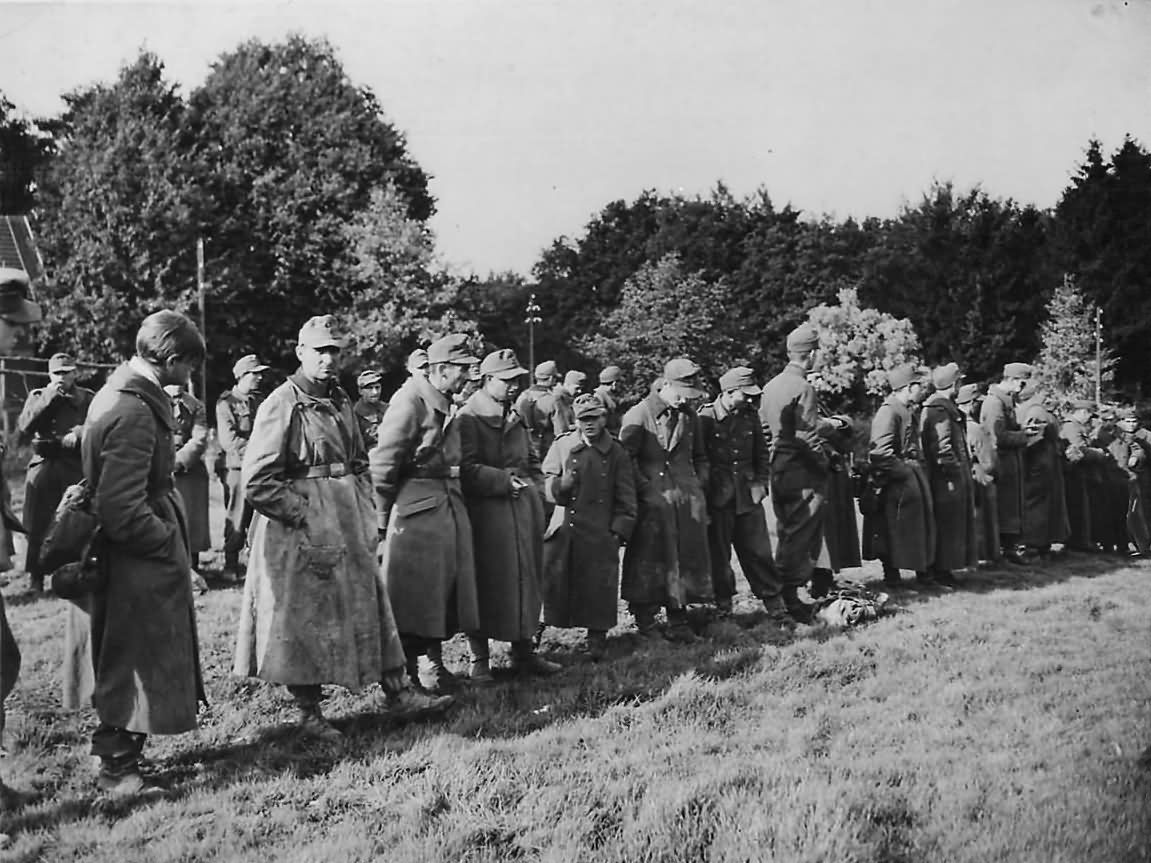 I took my runner, the 60, and the 81-MM mortar observers to their OPs and had my communication Sgt lay wires to all platoons and OPs. It was now 1530, and our casualties were being evacuated to the battalion aid station in Verlautanheide. I returned up the Hill to our OPs and began to register points and pick out our final protective line. The artillery and mortar concentrations were coordinated with the FAO and at 1730, I left to inspect my Cal .50 machine-gun section. I returned to Lt Marvain near pillbox #39 and decided to let him have one squad from the support platoon to occupy pillbox #59 and #40. We were then receiving heavy artillery and mortar fire, as well as some machine-gun and sniper fire from positions north of the Hill.
I took my runner, the 60, and the 81-MM mortar observers to their OPs and had my communication Sgt lay wires to all platoons and OPs. It was now 1530, and our casualties were being evacuated to the battalion aid station in Verlautanheide. I returned up the Hill to our OPs and began to register points and pick out our final protective line. The artillery and mortar concentrations were coordinated with the FAO and at 1730, I left to inspect my Cal .50 machine-gun section. I returned to Lt Marvain near pillbox #39 and decided to let him have one squad from the support platoon to occupy pillbox #59 and #40. We were then receiving heavy artillery and mortar fire, as well as some machine-gun and sniper fire from positions north of the Hill.
I alerted all rifle platoons along the line as well as the observers, that Sgt Almeter and I were going out front to the north of our position, and for everyone to keep his eyes open for machine guns and snipers. They were informed that we would be out about 200 yards, and across our entire front. We got about 300 yards northeast of the cemetery at pillbox #39 when we came under heavy small arms fire. At this time I got shot through the shoulder and Sgt Almeter got hit in the stomach. He fell to the ground. I picked him up to his knees and asked him if he could crawl back with me to pillbox #39, where I could get aid for him. We were nearing pillbox #39 when Lt Snyder saw the shape we were in. He rushed up the trail and gave me a hand with Lt Almeter.
Lt Snyder was down there checking with Lt Marvain on our defense plans. I got a man from Lt Marvain to help me get Lt Almeter to the Company CP at pillbox #26. The Aid man administered some emergency  aid to Lt Almeter, and with the PW’s we had in the CP, we removed some bunks from the pillboxes and had the PW’s as litter bearers to carry our casualties back to the Battalion Aid Station in Verlautenheide.
aid to Lt Almeter, and with the PW’s we had in the CP, we removed some bunks from the pillboxes and had the PW’s as litter bearers to carry our casualties back to the Battalion Aid Station in Verlautenheide.
It was then about 1830. When I got to my PC the Battalion S-3 where there and wanted to check my final protective fires of the battalion. He also told me that Baker 18 had moved into the gap along the ridgeline from Verlautenheide. I had the Aid man do some first aid work on me, and the 1/Sgt had some hot coffee.
As you know, these pillboxes have stoves in them. I returned to the Battalion CP with Capt McGreoger and got all the orders for the night, and put out some additional listening posts and waited for the expected counter-attack that did not come off until 0400 Oct 9. The enemy attempted to take over Crucifix Hill by storm. Three waves of infantrymen and assault engineers moved up northern and western slopes. The men of the company held their small arms fire until the Jerries were almost upon them. Then, as the enemy was eliminated by our artillery flares and WP shells, they opened up with a murderous gazing fire that piled the onrushing Germans in front of their foxholes.
The Cal .50 machine-gun Section, Dog 18, commanded by Lt Yardor (Yardbird), particularly distinguished itself. The gunners, swinging their guns with free traverse, blazed away at every enemy in sight. The 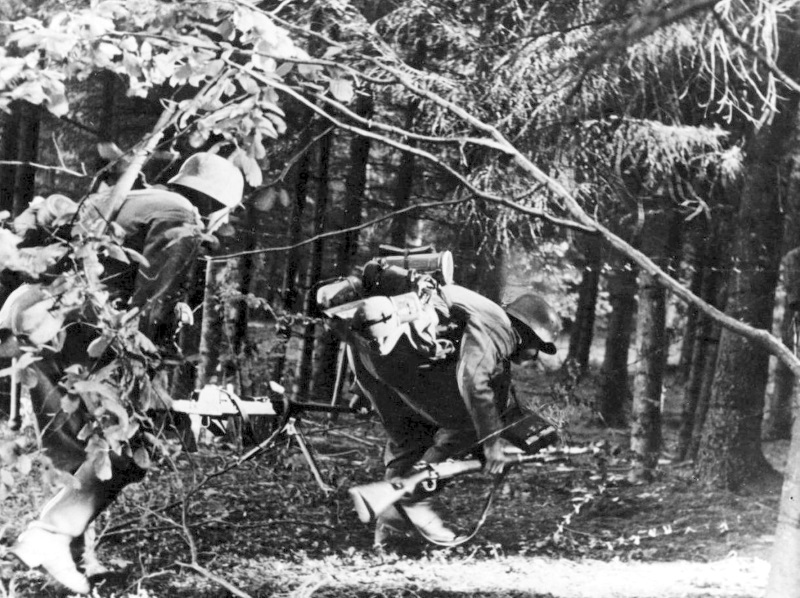 enemy (or whatever shattered remnants were left) withdrew as suddenly as they had attacked, leaving behind forty-odd dead within our bloody rock-throwing distance; also leaving thirty-five prisoners. Over one hundred dead could be seen out in the path of the artillery and mortar fire.
enemy (or whatever shattered remnants were left) withdrew as suddenly as they had attacked, leaving behind forty-odd dead within our bloody rock-throwing distance; also leaving thirty-five prisoners. Over one hundred dead could be seen out in the path of the artillery and mortar fire.
Sixty men and officers from the 18-IR died on the battlefield that day, and more were to follow in the face of the desperate enemy counter-attacks. It was rugged going; but Crucifix Hill no longer looked down our throats, upon our front lines, or rear areas. Able 18 failed to gain its objective, thereby leaving Charlie 18 on Crucifix Hill exposed in all directions except to the east. This compelled Charlie 18 and the attached Rangers to defend in three directions, north, south, and west, totaling approximately 1700 yards about the hill. Later on in the morning, two self-propelled 155-MM guns were placed north of Eilendorf to engage the enemy strong points still holding out against Able 18 in the vicinity of pillbox #17, #18, and #19. The guns succeeded in smashing 2 pillboxes completely and laid deadly fire on the rest of the enemy in the area.
The battalion commander ordered me to have my support platoon assist Able 18 by attacking the pillboxes from the rear and the west side. This succeeded in dislodging the enemy from many of his positions. Heavy casualties were inflicted upon the enemy, and 12 prisoners were taken; thus completing the Battalion mission. Able 18 tied in with Charlie 18 by fire near the trail on the south side of Crucifix Hill about 1300, Oct 9, however, I think, if Baker 18 had been ordered to push up south of Crucifix Hill within Charlie’s zone of action in the late evening of Oct 8, and assaulted the pillboxes from the rear, or west, which were holding Able 18 up, it would have saved time and lives. The mission of the battalion would have been completed much faster and would have closed the rear of Charlie 18, thus allowing them more men with which to meet the enemy threats from the north and northwest. This completed one of the most difficult and important missions ever assigned the 1/18-IR of the 1-ID. The total number of casualties from Charlie Co in the attack on Crucifix Hill in the Aachen Offensive, Oct 8, 1944, (Rhineland campaign), was as follows: Charlie 18: KIA, 0 Officer, 5 EM, WIA, 2 Officers, 33 EM, Captured, None. Ranger Plat.: KIA, 1 Officer, 3 EM, WIA, 1 Officer, 6 EM, Captured, None.
The Enemy side: KIA, 150 EM and Officers, WIA, 1 Officer, 20 EM, Captured, 1 Officer & 75 EM.

